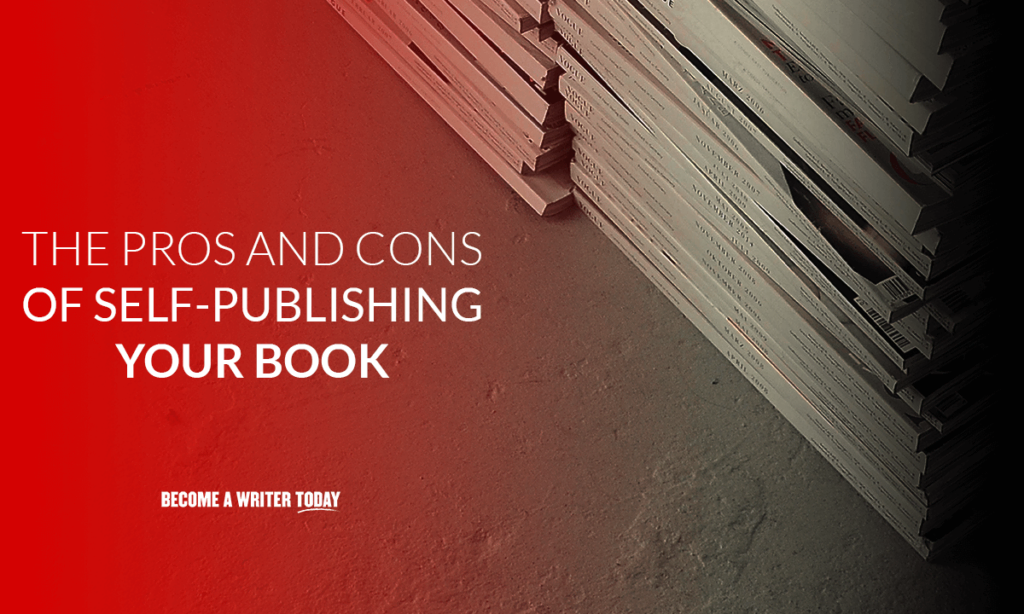In this article, Mark O’Neill explains the pros and cons of self-publishing your book for indie authors.
If you’re considering jumping into the exciting world of self-publishing, then congratulations. It’s a very wild adrenalin ride, and you’ll end up learning a lot and hopefully earning a lot, too, as you work your way towards being a successful author.
But before you commit, you need to fully balance the pros and cons of self-publishing to know what you are getting yourself into and whether self-publishing is the correct route for you to go in your writing career.
As a self-published author of 17 books, here are the pros and cons I’ve learned over the past few years, which you should know about.
Contents
- The Pros
- 1. You Can Share Your Story With Readers
- 2. You’ll Earn a Higher Royalty Rate
- 3. You’ve 100% Control Over The Creative Process
- 4. You Can Get Your Books Into Lending Libraries
- The Cons
- 1. Jumping From Self-published to Traditionally Published is Challenging
- 2. You’re Paying For Everything Upfront
- 3. Getting Your Books Into Bookstores Is Difficult
- 4. Winning Prestigious Prizes And Getting Onto The New York Times Bestseller List Is Off-Limits
- The Final Word on The Pros and Cons of Self-publishing: It’s Tough, But Self-Publishing Is Worth It
The Pros

Let’s start off with some pros, as everybody likes to start with good news. Self-publishing a book is a great opportunity that aspiring authors would have given anything for years ago. Here’s why.
Have you ever had a great idea for a book, then proceeded to excitedly explain it to someone, only to be met with a shake of the head and maybe a sarcastic comment? A story idea you love might not be reciprocated by others, including literary agents and potential publishers.
They may not “see your vision” or be convinced that a story about Hobbits needing to take a ring to an evil mountain is a viable proposition. Or that a boy wizard with a scar on his forehead will recoup the $2,000 advance.
Self-publishing allows you to bypass all of that doubt by others and publish the book yourself. Then when the book sells, you can prove to all the naysayers that the book idea was indeed a publishing success. You can then sit back and collect 70% royalties from Amazon while traditional publishers gnash their teeth, wailing at the lost opportunity.
2. You’ll Earn a Higher Royalty Rate
As I just mentioned, Amazon gives their independent authors up to 70% in royalties (depending on the sales price). This is a vast difference compared to what you would get from a traditional publisher.
Traditional publishers take the lion’s share of the book sales price because they think they do most of the work. In their mind, they do editing, formatting, printing, distribution, marketing, and advertising.
As far as they’re concerned, you’re “just” sitting at home writing the actual book. For that, they think you’re entitled to a measly few percent on each book sale.
But what they fail to realize is that without the actual book, they wouldn’t have any money for themselves at all. As the author, YOU should be getting the lion’s share of the sales price — or at least 50% of it. This short-sightedness in the publishing world is slowly turning authors against the idea of traditional publishing completely.
3. You’ve 100% Control Over The Creative Process

There are many moving parts to a book — the digital eBook, the print book, the audiobook, the translated versions, the screenplay, merchandising, comics, computer games, and more.
But traditional publishers are narrow-minded and old-fashioned in their thinking and don’t fully consider all avenues of generating revenue. I don’t know about you, but it would personally frustrate me if I saw money being left on the table by a traditional publisher too lazy to pick it up.
As a self-publisher, though, you have complete creative control over the book publishing process. If you see a way to develop your work further and make a bigger profit, then you can go right ahead and do it. The only limit is how far your imagination can go in finding different ways to make money from your book.
4. You Can Get Your Books Into Lending Libraries
If you’re prepared to bypass Kindle Unlimited and “go wide” with various publishing platforms, you can also get your book into lending libraries. However, before you dismiss libraries as places where people can read your work for free, remember that libraries have a budget for buying books — and they’re always looking for new titles. Especially if people hear about your work and ask the library to get your books into their system.
Publishing your books on a platform such as Draft2Digital also gives you the option of sending your titles to lending libraries, where you can set the sale price of up to three times the usual sales price. So libraries are a great place to get your work into, and self-publishing has only made it more accessible.

The Cons
As with everything else in life, there are cons to self-publishing too. Although, as an optimistic person, I always see most cons as something that’s only a con if you want it to be. Having the know-how to turn a con into a pro is also part of the fun.
1. Jumping From Self-published to Traditionally Published is Challenging
Unfortunately, there’s an unfair stigma attached to self-publishing as it used to have a bad reputation before Amazon came along. The snobbishness prevalent in the traditional publishing industry considers self-publishing as a bad thing, and people imperiously look down on indie authors — despite the fact we’re making more money than them! Maybe it’s jealousy?
Whatever the reason, once you go self-published, then making the leap into the traditional publishing world and getting a book deal from a publishing house is extremely difficult, if not bordering on impossible.
It’s not completely impossible though — I know of at least two indie bestselling authors who were offered traditional book deals after the success of their self-published titles. But they’re definitely the exception rather than the rule.
2. You’re Paying For Everything Upfront
There’s no way around it — everything that will hopefully generate revenue and eventual profit will require an upfront cash injection. Nobody and nothing works for free, including a proofreader, professional editing, a book cover designer, a formatter, a website, an email list, and various book marketing costs.
I know plenty of people who have whipped out the Visa or Mastercard without a second thought. But if you have any savings salted away, I’d suggest laying off the credit card. You’re only going to get yourself into debt.
The good news is that you won’t need a lot of money. I would estimate that my first book cost me around $500 in start-up costs because I was bootstrapping. That book has gone on to earn at least six times as much (and counting). But if you don’t have the money readily available, you will need to think about how you’re going to fund it.
3. Getting Your Books Into Bookstores Is Difficult

One dream of an author is walking into a bookstore and seeing their book on the shelf. Bonus points if admiring customers are reading the book and heading towards the cashier.
But the sad truth is that self-publishers face a steep uphill battle in getting their books into bookstores. Bookstores deal with distributors who generally don’t do business with self-published authors. So forget any ideas of walking into a bookstore with a bag of books in the hopes of making a deal with them. In all likelihood, they won’t bother humoring you.
The one ray of hope is that Amazon KDP is now giving you the chance of getting your books onto bookstore bookshelves. But Amazon will raise your book’s sale price so much that the likelihood of actually selling your book will be greatly diminished. What one hand giveth, the other hand taketh away. That said, you can try using a service like IngramSpark to sell your book into traditional stores.
4. Winning Prestigious Prizes And Getting Onto The New York Times Bestseller List Is Off-Limits
Maybe you also have dreams of winning the Booker Prize or the Nobel Prize for Literature? Or perhaps you’ve slightly lowered your sights and are aiming for the New York Times Bestseller List instead? If you’re self-published, you can pretty much forget all of this.
As I said, traditional publishers are pretty arrogant and snobbish towards independent authors. Most likely because they see self-publishing as a real threat to the status quo. That same arrogance and snobbishness also extend to literary awards committees. The sad fact is that no literary award is going to consider an indie author — period.
The New York Times doesn’t hold any such prejudices (at least as far as I’m aware). But the reality is that as a self-published author, you won’t be able to sell enough copies of your book to remotely have a chance of hitting the List. On the other hand, you do have a chance of the USA Today Bestseller List (for what that’s worth).
The Final Word on The Pros and Cons of Self-publishing: It’s Tough, But Self-Publishing Is Worth It
There are many pros and cons to self-publishing, and this article only scratches the surface of them. But with everything in life, you only get out what you put into it. If you’re determined, fearless, and refuse to give up, the money will come. And really, what’s more important? A literary prize or cold hard cash? Me, I’ll take the cash any day of the week.